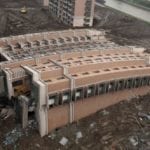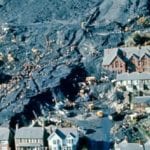 Crime
Crime  Crime
Crime  Technology
Technology 10 Hilariously Over-Engineered Solutions to Simple Problems
 Miscellaneous
Miscellaneous 10 Ironic News Stories Straight out of an Alanis Morissette Song
 Politics
Politics 10 Lesser-Known Far-Right Groups of the 21st Century
 History
History Ten Revealing Facts about Daily Domestic Life in the Old West
 Weird Stuff
Weird Stuff 10 Everyday Products Surprisingly Made by Inmates
 Movies and TV
Movies and TV 10 Actors Dragged out of Retirement for One Key Role
 Creepy
Creepy 10 Lesser-Known Shapeshifter Legends from Around the World
 Animals
Animals 10 Amazing Animal Tales from the Ancient World
 Gaming
Gaming 10 Game Characters Everyone Hated Playing
 Crime
Crime 10 Terrifying Serial Killers from Centuries Ago
 Technology
Technology 10 Hilariously Over-Engineered Solutions to Simple Problems
 Miscellaneous
Miscellaneous 10 Ironic News Stories Straight out of an Alanis Morissette Song
Who's Behind Listverse?

Jamie Frater
Head Editor
Jamie founded Listverse due to an insatiable desire to share fascinating, obscure, and bizarre facts. He has been a guest speaker on numerous national radio and television stations and is a five time published author.
More About Us Politics
Politics 10 Lesser-Known Far-Right Groups of the 21st Century
 History
History Ten Revealing Facts about Daily Domestic Life in the Old West
 Weird Stuff
Weird Stuff 10 Everyday Products Surprisingly Made by Inmates
 Movies and TV
Movies and TV 10 Actors Dragged out of Retirement for One Key Role
 Creepy
Creepy 10 Lesser-Known Shapeshifter Legends from Around the World
 Animals
Animals 10 Amazing Animal Tales from the Ancient World
 Gaming
Gaming 10 Game Characters Everyone Hated Playing
Top 10 Haunting Images Of Historic Tragedies [DISTURBING]
Tragedies such as bombings, wars, terrorist attacks, natural disasters, and personal calamities have left a permanent dent in history’s timeline. As modern generations navigate their own catastrophes, the events of yesteryear still echo, demanding never to be forgotten.
On this list are haunting images taken during and after terrible tragedies. They reflect the severe impact of these events at the time and in the years to come.
Warning: Some images may disturb sensitive viewers.
10 Shadows Remain After Bodies Are ‘Vaporized’ During Nuclear Blast
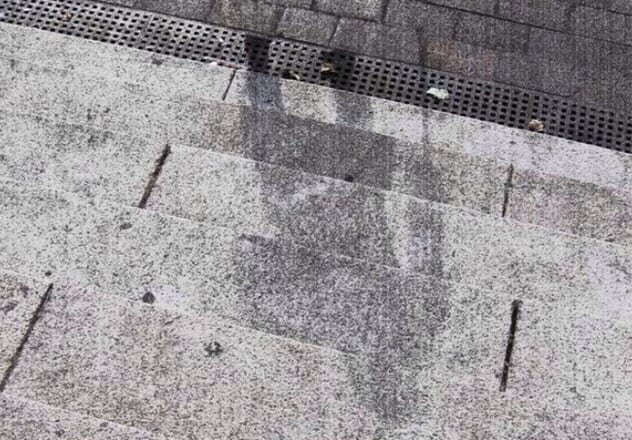
When the nuclear bomb was dropped on Hiroshima on August 6, 1945, people were going about their day not knowing the terror at hand. The intense heat from the blast caused “shadows” to be burned into nearby surfaces, reflecting the object that had been there mere seconds before.[1]
This happened with human victims as well. Their likenesses were burned into the walls or surfaces closest to where they were standing or sitting when the blast occurred. This picture is the last reminder of a man who had been sitting or walking on the stairs as the bomb hit. For more sobering facts nearly lost to time, read 10 Facts Everyone Forgets About World War II.
9 Monument To Commemorate Fallen New Zealand Soldiers

Two years after the fierce Battle of the Somme during World War I, New Zealand soldiers erected a massive cross in memory of the comrades who had lost their lives during the fighting.[2] This photo depicts two of these soldiers digging a hole in which to erect the monument.
Surprisingly, there have also been people who have erected monuments to their foes. Read more at 10 Times People Erected Public Monuments To Their Enemies.
8 Listening For Signs Of Life
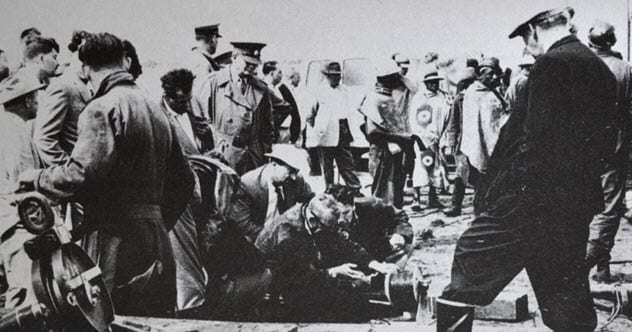
On December 28, 1959, part of the Coalbrook mine just outside Sasolburg in the Free State, South Africa, collapsed, injuring one miner. A mine inspector was called in. He visited the site within two weeks but was not told of the incident. His report didn’t show any abnormalities inside the mine.
Tragically, on January 21, 1960, Section 10 of the mine collapsed piece by piece while 1,000 miners were underground. 435 miners remained trapped after the rest were able to escape.[3]
This picture depicts rescue workers sinking sound equipment into the shaft to try to hear signs of life from the trapped miners. Rescue efforts continued in vain for two weeks. On February 5, 1960, it was decided that all efforts should be stopped. All 435 miners died underground, and their bodies were never brought to the surface.
Unfortunately, horrific fatal accidents have occurred aboveground, too. Read about some of the most frightening in Top 10 Freak Airplane Incidents And Accidents.
7 More Than 900 Drink Laced ‘Kool-Aid’ At The Behest Of A Crazy Cult Leader
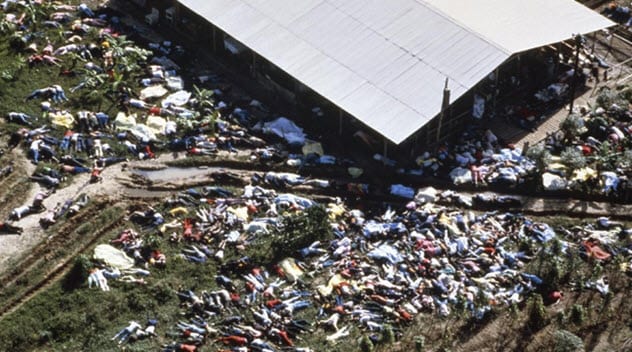
On November 19, 1978, Jim Jones murdered more than 900 people in Guyana. He gave them cyanide-laced Flavor Aid to drink after telling them to synchronize their watches.[4]
The result was mass death rivaled only by the events of 9/11. This grim picture is a reminder of how easy it is for charismatic psychopaths to infiltrate the minds of vulnerable people. Even so, there are some angles to this story that point in another direction. To learn more, check out 10 Things That Don’t Quite Add Up About The Jonestown Massacre.
6 If I Fail, He Dies
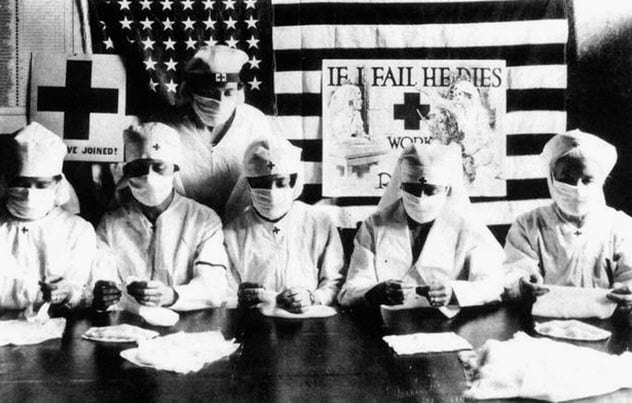
In an image eerily reminiscent of the situation the world is currently facing, this picture depicts Red Cross volunteers making face masks during the 1918 Spanish flu pandemic.[5]
The pandemic lasted from January 1918 to December 1920 and resulted in the deaths of over 50 million people worldwide. One can only imagine the type of determination that resulted from the poster stuck against the flag in the background. Unfortunately, this is not the only pandemic the world has faced. Read more at Top 10 Deadly Pandemics Of The Past.
5 Walking Into Disaster
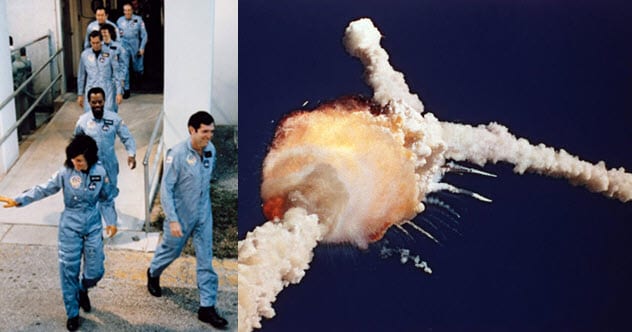
The image on the left shows the crew on their way to board the Space Shuttle Challenger for their mission to space on January 28, 1986. They look happy, excited, and obviously completely unaware that they will not return alive. Or at all.[6]
Seventy-three seconds after the launch of the Challenger, the spacecraft broke apart in the air, killing all aboard. To discover more about space catastrophes, read 10 Horrific Disasters Of The Space Program.
4 Leaving War Only To Find Heartbreak
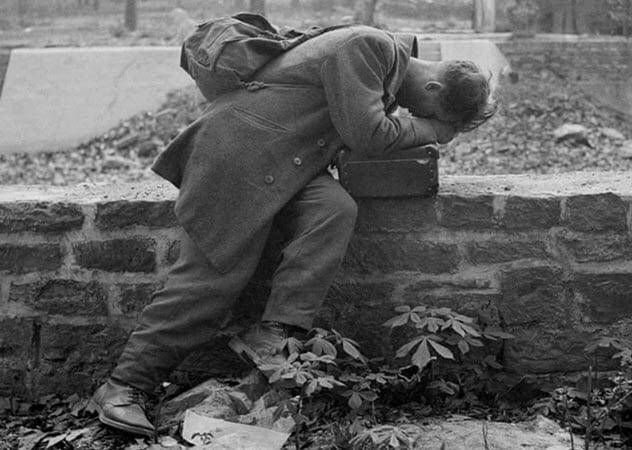
After surviving the devastation of World War II, this unnamed German soldier couldn’t wait to return home.[7]
Tragically, as he arrives at the place he once called home, he finds nothing but burned remains of the structure. Then he learns that his entire family died after air raids by Allied forces. Get your tissues ready before you click to read more heartbreaking tales in 10 Incredibly Tragic Stories Surrounding Devastating Wars.
3 Soldiers Horrified By Footage Of Concentration Camps
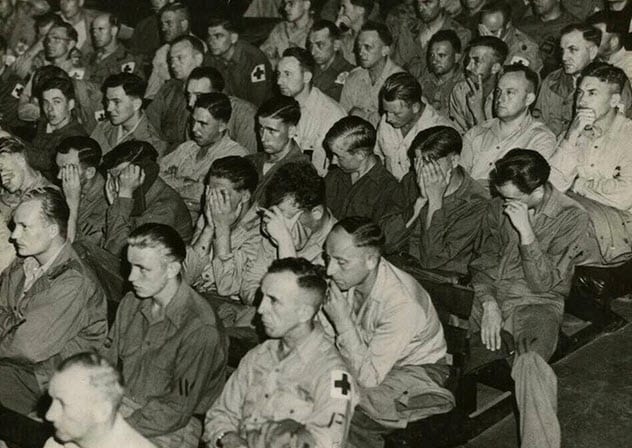
Although many Germans were aware of the mass slayings of Jewish people during the Holocaust, it is believed that some did not know about the atrocities in concentration camps. By the beginning of 1945, an estimated 1.1 million people had been killed at Auschwitz.[8]
This image reflects the horror that some German soldiers (who were prisoners of war) experienced after being forced to watch footage from the concentration camps in 1945. Despite all the tragedy, there was still some hope as told in 10 Remarkable People Who Escaped From Auschwitz.
2 Punishment For Not Meeting Daily Quota
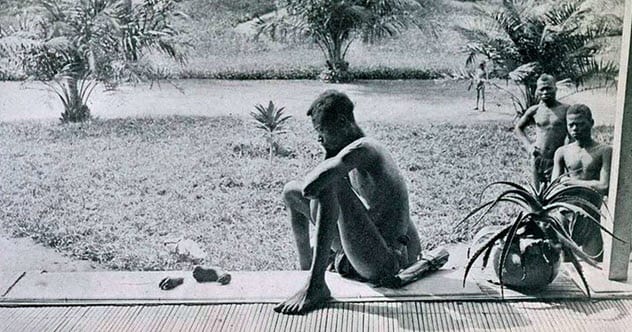
During the reign of King Leopold II of Belgium in Congo, the man in this picture, Nsala, failed to reach his daily rubber collection quota in 1904. As punishment, the Belgian overseers cut off his five-year-old daughter’s hand and foot.[9]
Nsala is staring at the dismembered remains here. The overseers then killed his daughter and wife and cannibalized both. If you want to know more about the atrocities that occurred in the Congo Free State under Leopold’s rule, click on 10 Horrifying Facts About The Genocide In The Congo Free State.
1 Barely Alive
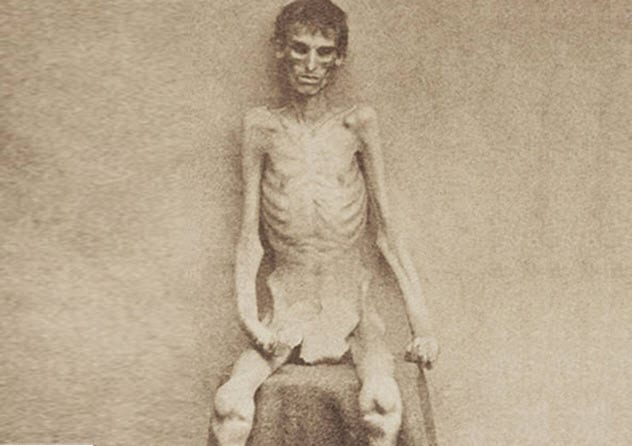
This disturbing photograph is just one piece of evidence of the atrocities that occurred in the Andersonville Prison, eventually known as the worst prisoner-of-war camp ever in the US. Soldiers were fed regularly; prisoners were not.[10]
The man in this image, a Union Army soldier, barely survived the Andersonville Prison after wasting away from hunger during the US Civil War. He was eventually released in May 1865. You can read more about Andersonville at Top 10 Infamous Wartime Prisons.




![10 Worst Massacres Of African-Americans [DISTURBING IMAGES] 10 Worst Massacres Of African-Americans [DISTURBING IMAGES]](https://listverse.com/wp-content/uploads/2019/10/vote-150x150.jpg)
![10 Creepy Images From American Courtrooms [Disturbing] 10 Creepy Images From American Courtrooms [Disturbing]](https://listverse.com/wp-content/uploads/2020/05/85-150x150.jpeg)
